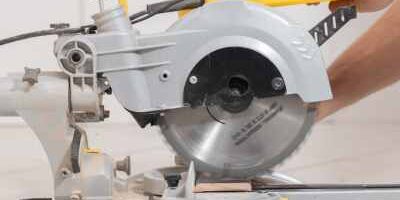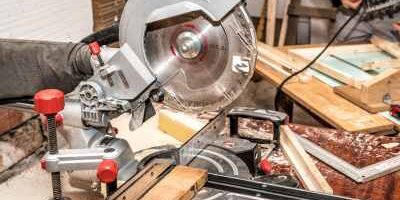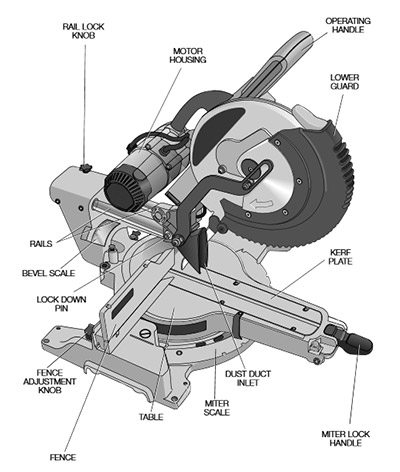
This is a popular power tool because there are many types of miter saws. It’s a popular power tool for its many uses in various workspaces. It uses a circular blade and a big circular-style saw that spins at high speeds to perform different cuts. There are different sizes and styles, which we will cover in this guide. Due to their accuracy and control, these tools are a proven, reliable choice. Owning a miter saw can take your construction or home improvement game to a new level. Typical uses for a miter saw include:
- Crosscuts
- Trim cuts
- Angled cuts
- compound angled cuts
- Molding
- Joints
- Door frames
- Flooring
- Cuts involving repetition
To begin, there are three main types of miter saws: standard, compound, and sliding. They are all very commonly used in home improvement, as well as construction.
The Power Miter Saw
First, the basic miter saw, also commonly known as a drop saw or chop saw, can perform two main types of cuts: cross cuts and miter cuts. They are limited in the variety of cuts but are great for simple cutting tasks. They are usually lighter and more affordable than other types. And they tend to be stable and accurate due to the fewer moving parts in their design.
The Compound Miter Saw
Add to the standard miter saw a tilting feature, and you get a compound miter saw. This particular miter saw performs cuts that is made at an angle, a slope, or a bevel. Angle plus bevel makes it a compound cut. A main feature of a compound miter is the blade tilt, and there are two types available; a single bevel (one side) and a double bevel (two sides). This tilt usually ranges from 0 to 45 degrees. Giving you much more cutting angles. A much-needed option in many situations. A compound saw is said to be the most versatile. It can do many cuts accurately: crosscut, bevel, compound, and standard miter cuts.
The Sliding Miter Saw
The sliding miter saw is a bit different from the compound miter saw in a few ways. The sliding miter saw works by sliding its cutting arm. This radial arm can move up, down, in, and out. Opening up many cutting angles and styles. In some cases, it can even double the cutting dimensions. While it does have the sliding advantage over the compound, saw, this feature may not be used often and it makes the machine a bit bulkier. Weigh these options before you spend the extra cash on something you don’t really need.
Finally, all three miter saw types can be combined into one powerful tool, the sliding compound miter saw. This style gives you the advantages of both worlds, giving you the widest range of cutting angles, bevels, and capacities.
Single Bevel vs. Dual Bevel
When it comes down to choosing a miter saw, you will see terms like “single bevel” and “dual bevel”; these terms are associated with compound-style miter saws. A miter saw can cut at angles, while a compound miter saw can also cut bevels and slopes. Let’s get into more details.
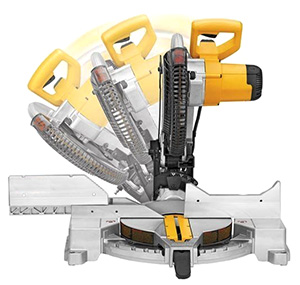
The Single Bevel Miter Saw
Bevel cuts are great for doing various tasks such as doorstops, frames, etc. For example, you may make a bevel cut on a soft wood wall trim to smooth it out. Not only will it look great, but it will also keep the edges from being too rough or sharp.
A single bevel miter saw is the more commonly used type. They are limited in the fact that they can only make bevel cuts to the right or to the left. That’s not a bad thing; not all jobs will need more than that. However, if you need to cut on both sides of the working surface or material – and you find this happening often – then go with a dual bevel. Noting that a single bevel will save you almost half of what you would spend on a dual bevel.
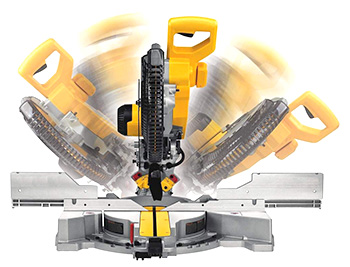
The Dual Bevel Miter Saw
Typical uses are the same; however, the dual bevel will be able to do more advanced crown moldings. This is due to the nature of the bevel itself: being able to swing it over and do more complex cuts is supreme in this regard.
A double bevel miter saw will make bevel cuts a cinch. Instead of having to flip the material over to make new measurements and cuts, the saw can move to do the cut. This gives the dual bevel type of miter saws a serious advantage. If your jobs usually involve a lot of bevel cuts, then it will be wise to consider going with a dual bevel miter saw. A downside to the dual bevel is cost. They tend to run higher, and while they won’t usually bust your bank, you can expect to spend more.
10 inch vs. 12 inch
Miter saws are usually produced in two main blade diameters: the 10-inch and the 12-inch. Of course, both are perfectly great options. However, there are cases where one or the other is better suited. We’ll dive in and look at those situations so that you can make a better decision.

The 10 Inch Miter Saw
The first upside to owning a 10-inch miter saw is that they spin at high RPM speeds. This is very important if you need to make tons of quick cuts and don’t work with super-strong surfaces. A higher cutting speed is better in a general-purpose setting. Also, 10-inch blade miter saws are a little lighter. This can significantly differ if you move around your job site often. Additionally, 10-inch blades are more commonly available in stores.
The main drawback is that the cutting depth will be less than the 12-inch counterparts. You will get somewhere around 6 inches of depth versus a bigger blade will get you around 7+ inches.
The 12 Inch Miter Saw
A 12-inch blade miter is a great choice for those who need slower cutting speeds but higher torque. Say that you work with surfaces quite thick or hard to cut. A 12-inch blade miter saw and then some will usually do the trick. A 10-inch won’t be able to stand up to those specific challenges.
12-inch blade saws can be more expensive. If you are working on a tight budget, that might not be the best option. Also, they tend to be a bit heavier.
In Summary
All things considered, learning how to use it will make you understand the limitations or flexibility of miter saws. After all, there are no major differences in the two sizes besides size itself. One blade cuts a bit faster, while the other can perform against denser materials with more ease. That’s really what it will boil down to. That and cost. However, you may find yourself leaning towards the blade size that will cover more ground. It is also important to note that a 12-inch miter saw can not use 10-inch blades. The saw setup will restrict you from using a blade of different size for safety reasons. More information of a general nature is found in our miter saw guide.

